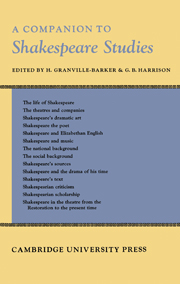Book contents
- Frontmatter
- Contents
- ILLUSTRATIONS
- Preface
- The Life of Shakespeare
- The Theatres and Companies
- Shakespeare's Dramatic Art
- Shakespeare the Poet
- Shakespeare and Elizabethan English
- Shakespeare and Music
- The National Background
- The Social Background
- Shakespeare's Sources
- Shakespeare and the Drama of his Time
- Shakespeare's Text
- Shakespearian Criticism
- Shakespearian Scholarship
- Shakespeare in the Theatre from the Restoration to the Present Time
- Reading List
- Appendices
- Index
- Plate section
Shakespeare and Elizabethan English
Published online by Cambridge University Press: 05 August 2012
- Frontmatter
- Contents
- ILLUSTRATIONS
- Preface
- The Life of Shakespeare
- The Theatres and Companies
- Shakespeare's Dramatic Art
- Shakespeare the Poet
- Shakespeare and Elizabethan English
- Shakespeare and Music
- The National Background
- The Social Background
- Shakespeare's Sources
- Shakespeare and the Drama of his Time
- Shakespeare's Text
- Shakespearian Criticism
- Shakespearian Scholarship
- Shakespeare in the Theatre from the Restoration to the Present Time
- Reading List
- Appendices
- Index
- Plate section
Summary
ELIZABETHAN ENGLISH IN GENERAL; THE LANGUAGE OF THE COURT AND OF THE STAGE
Any well-annotated edition of a Shakespeare play introduces one to some of the types of linguistic change which, together with alterations in customs and thought, make a veil or barrier between the sixteenth century and ourselves. Some of the commonest Shakespearian tags–for example, ‘Thus conscience does make cowards of us all’–require a linguistic note of some kind to enable the beginner to understand their original, Elizabethan, meaning. The points which play the maximum part in ordinary language notes on Shakespeare are concerned with lexicography (additions and losses in vocabulary), semantics (alterations in the meanings and associations of words), accidence and syntax (changes in inflexion and construction). In addition there are equally far-reaching phonological changes. Our phonetic equivalents for vowel and consonant symbols are not die same as the Elizabethan: the symbols ee (as in meet) and ea (as in beat) have now only one phonetic value and the words can rhyme; in the late sixteenth century the two symbols still denoted two distinct vowel sounds. There have as well been countless alterations in the pronunciations of individual words, of which the most prolific cause has been the desire to make the pronunciation fit a traditional spelling.
- Type
- Chapter
- Information
- Companion to Shakespeare Studies , pp. 117 - 136Publisher: Cambridge University PressPrint publication year: 1934



